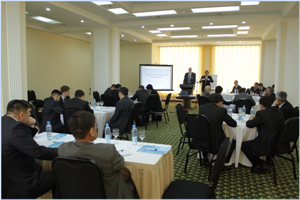Operation TARCET: Prevent the Illicit Manufacturing of Heroin
 This latest TARCET operation resulted in the seizure of 28 metric tonnes of precursor chemicals, which includes 15 tonnes of acetic anhydride. This quantity of acetic anhydride would allow to manufacture heroin, worth more than 3.5 million US$ in the illicit markets of the Russian Federation and European states. Precursor chemicals are substances that are used to manufacture heroin from raw opium. While there are many such chemicals, the chemical acetic anhydride is crucial in the heroin manufacturing process.
This latest TARCET operation resulted in the seizure of 28 metric tonnes of precursor chemicals, which includes 15 tonnes of acetic anhydride. This quantity of acetic anhydride would allow to manufacture heroin, worth more than 3.5 million US$ in the illicit markets of the Russian Federation and European states. Precursor chemicals are substances that are used to manufacture heroin from raw opium. While there are many such chemicals, the chemical acetic anhydride is crucial in the heroin manufacturing process.
The work undertaken to prevent the smuggling of precursor chemicals into Afghanistan, as well as plans to advance this effort in the future, were discussed during the Operation TARCET III debriefing meeting in Beijing, China, in November. This important event was convened by the United Nations Office on Drugs and Crime's Regional Office for Central Asia (UNODC ROCA), the UNODC Country Office for Afghanistan, the European Commission and the Office of the National Narcotics Control Commission of China (ONNCC). All 14 countries and 2 international organisations in attendance reviewed the results of Operation TARCET III (as conducted in 2010), while recommending further precursor control and interdiction activities to be conducted in order to prevent the illicit manufacturing of heroin in Afghanistan.
Operation TARCET III was conducted in Afghanistan, the Islamic Republic of Iran, Kazakhstan, Kyrgyzstan, Pakistan, Turkmenistan and Uzbekistan. It was undertaken with the technical support of Paris Pact Partners, including France, Italy and the United Kingdom, along with donor support from Canada, the European Commission, France and the United States. This operation has involved three principle approaches, including the conducting of training courses, the development and production of relevant training materials, and the procurement of necessary equipment.
A number of training sessions have occurred within the operation's framework on national and regional levels, with the participation of global experts from organisations including but limited to the Metropolitan Police, the Forensic Department of the Italian Police, the French Customs Service and the German Federal Police.
More than 100 Central Asian law enforcement officers have been trained within this program, in regards to the identification of suspicious consignments based on risk indicators, the identification of precursors, the planning of operations, command protocols, and the importance of human rights in regards to policing. Other matters addressed included controlled deliveries, the main provisions of the TIR Convention and the use of specialist equipment.
Operation TARCET III also involved the procurement of equipment for the mobile precursor team recently established within the State Service on Drug Control of the Kyrgyz Republic.
The entire TARCET initiative, including the operations TARCET I and TARCET II conducted in 2008 and 2010 respectively, has led to important developments in the region.
While no acetic anhydride seizures were reported in the countries surrounding Afghanistan from 2001 to 2008, seizures of the chemical have occurred regularly since. Individual examples include the seizure of 14 tonnes in March 2008, 5 tonnes in July 2009, and the 15,800 tonnes seized in Pakistan in March 2010. There have also been multiple seizures in Iran, including 5 tonnes in July 2008 and a total of 1 tonne throughout 2010. 400kg have been seized in Tajikistan. With this remarkable success, it is not surprising the TARCET operations represent the frontline against precursor chemical trafficking in Central Asia.